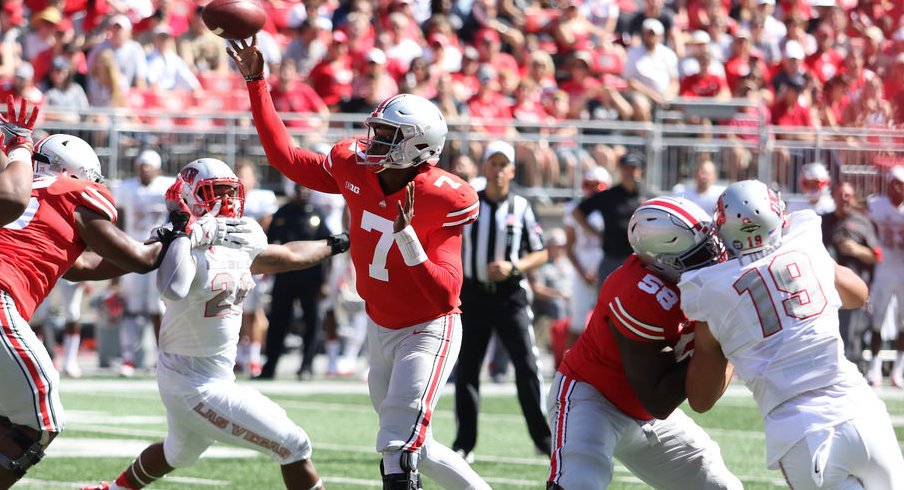Ohio State’s 54-21 win over UNLV on Saturday concluded with no shortage of impressive stats on both sides of the ball.
In addition to the final score, which was impressive in itself as it was Ohio State’s first 50-point effort of the year, the Buckeyes posted gaudy numbers on both sides of the ball. Offensively, the Buckeyes set a school record for most passing yards in a game. Defensively, the Buckeyes had more tackles for loss than they had in a game since 2008.
Those numbers make up two of our Three Key Stats from Saturday’s blowout win.
OHIO STATE PASSES FOR SCHOOL-RECORD 474 YARDS
Going into Saturday’s game in Columbus, Ohio State had never passed for more than 459 yards in a single game.
The Buckeyes eclipsed that record by 15 yards on Saturday as all three quarterbacks who saw playing time against UNLV effectively moved the ball down the field.
J.T. Barrett completed 12 of his 17 passes against the Rebels for 209 yards. Dwayne Haskins, who finished the first half and played nearly all of the second half, completed 15 of 23 passes for 228 yards. The Buckeyes gave third-string quarterback Joe Burrow the opportunity to throw four passes on their final possession of the game, and he completed all of them for 37 yards, moving Ohio State past the previous school record, which was set against Penn State in 1997.
Ohio State also set a new school record for most players with receiving touchdowns in a single game, and tied its school record for most touchdown passes in a game, with seven passing touchdowns all to different receivers. Parris Campbell, Johnnie Dixon, Binjimen Victor, Terry McLaurin and K.J. Hill caught touchdowns from Barrett, while C.J. Saunders and Rashod Berry caught touchdowns from Haskins. The Buckeyes never previously had more than five players with receiving touchdowns in a single game.
Campbell, who had three catches for 105 yards, and Saunders, who had six catches for 102 yards, became the first Buckeye duo to surpass 100 receiving yards in a single game since Ted Ginn and Santonio Holmes in 2005.
UNLV PASSES FOR ONLY 88 YARDS
Ohio State was ranked dead last in the Football Bowl Subdivision in passing defense after its first two games of the season against Indiana and Oklahoma, in which it allowed the Hoosiers and Sooners to combine for 806 passing yards.
The Buckeyes will sit in a much better position in the FBS rankings after its last two games.
Ohio State knew it wouldn’t have to worry about much passing offense in last week’s game against Army’s triple option offense. The Black Knights attempted only eight passes, completing only two for 19 yards. It’s more notable this week, though, that the Buckeyes held UNLV to only 88 passing yards on 19 passing attempts.
The Buckeyes will face much better passing offenses than the Rebels, who were ranked just 81st in the FBS with 206.5 passing yards per game going into Saturday. But the fact that the Buckeyes held UNLV to less than half of its average, while not allowing any big plays – UNLV’s longest passing completion of the day was 24 yards, and the Rebels did not have any passing touchdowns – indicates a step in the right direction for Ohio State’s passing defense, and was a big reason why the Buckeyes won by a big margin on Saturday.
OHIO STATE RECORDS 13 TACKLES FOR LOSS
One reason why Ohio State’s passing defense was more successful on Saturday was that the Buckeyes defensive front pretty much had its way with UNLV’s offensive line on Saturday, putting consistent pressure on Rebels quarterback Armani Rogers and recording four sacks.
Ohio State also regularly penetrated the backfield on running plays and made a multitude of tackles for loss against the run as a result.
In total, Ohio State’s 13 tackles for loss in Saturday’s game were the most the Buckeyes had in a single game since they also had 13 against Michigan in 2008.
Nick Bosa led the Buckeyes with three tackles for loss, including one sack. Malik Harrison had 1.5 tackles for loss, including an assisted sack. Isaiah Pryor, Jonathon Cooper, Denzel Ward, Jerome Baker and Dre’Mont Jones (whose tackle for loss was also good for a safety) were each credited with one tackle for loss. Erick Smith, Chase Young, Tuf Borland, Dylan Thompson, Pete Werner, Jashon Cornell and Tyquan Lewis were each credited with assisted tackles for loss.


